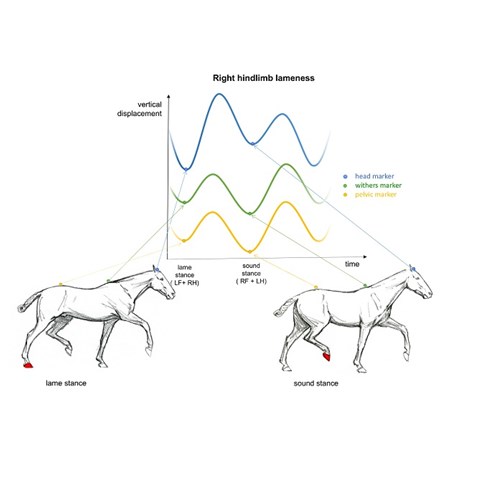Contact
Marie Rhodin
Researcher, Senior Lecturer at the Department of Anatomy, Physiology and Biochemistry (AFB)
Telephone: 018-672194
E-mail: marie.rhodin@slu.se

The main criteria for lameness assessment in horses are head movement for forelimb lameness and pelvic movement for hindlimb lameness. However, compensatory head nod in horses with primary hindlimb lameness is a well-known phenomenon. This compensatory head nod movement can be easily misinterpreted as a sign of primary ipsilateral forelimb lameness. Therefore, discriminating compensatory asymmetries from primary directly pain-related movement asymmetries is a prerequisite for successful lameness assessment.
To investigate the association between head, withers and pelvis movement asymmetry in horses with induced forelimb and hindlimb lameness.
Experimental study.
In 10 clinically sound Warmblood riding horses, forelimb and hindlimb lameness were induced using a sole pressure model. The horses were then trotted on a treadmill. Three-dimensional optical motion capture was used to collect kinematic data from reflective markers attached to the poll, withers and tubera sacrale. The magnitude and side (left or right) of the following symmetry parameters, vertical difference in minimum position, maximum position and range-up were calculated for head, withers, and pelvis. Mixed models were used to analyse data from induced forelimb and hindlimb lameness.
For each mm increase in pelvic asymmetry in response to hindlimb lameness induction, withers movement asymmetry increased by 0.35–0.55 mm, but towards the contralateral side. In induced forelimb lameness, for each mm increase in head movement asymmetry, withers movement asymmetry increased by 0.05–0.10 mm, in agreement with the head movement asymmetry direction, both indicating lameness in the induced forelimb.
Results must be confirmed in clinically lame horses trotting overground.
The vertical asymmetry pattern of the withers discriminated a head nod associated with true forelimb lameness from the compensatory head movement asymmetry caused by primary hindlimb lameness. Measuring movement symmetry of the withers may, thus, aid in determining primary lameness location.
https://onlinelibrary.wiley.com/doi/epdf/10.1111/evj.12844
M. Rhodin, E. Persson‐Sjodin, A. Egenvall, F.M. Serra Bragança, T. Pfau, L. Roepstorff, M.A. Weishaupt, M.H. Thomsen, P.R. van Weeren and E. Hernlund. Vertical movement symmetry of the withers in horses with induced forelimb and hindlimb lameness at trot. Equine Veterinary Journal, (2018) 1–7.
Marie Rhodin
Researcher, Senior Lecturer at the Department of Anatomy, Physiology and Biochemistry (AFB)
Telephone: 018-672194
E-mail: marie.rhodin@slu.se